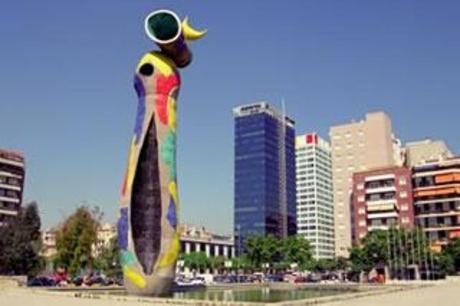Parc de Joan Miró
Built in homage to one of Barcelona's favorite native sons, Parc Joan Miró is a tribute to the surrealist imagination of this 20th century painter and sculptor.
Joan Miró was born in Barcelona in 1893 and studied at the Barcelona School of Fine Arts and the Academia Galí. His early works were reminiscent of Catalan folk art, yet one could detect the flavor of cubism in his paintings. After he moved to Paris and studied there in the 1920s, he began to develop what was to become his signature style, Surrealism. He also experimented with other media besides painting, including etchings, lithographs, and ceramic sculptures. Miro died in 1983.
In 1979, Barcelona began dismantling its old municipal slaughterhouse. The result was the first large urban park of the post-Franco Barcelona: a city which sought to renew itself and instinctively knew that it was necessary to undertake planning projects that would address new social needs and bring about the renovation of obsolete sites for new uses. In this case, a group of young architects, headed by Beth Galí, designed a park that occupies four blocks of the Eixample, which Ildefons Cerdà – the architect behind the Eixample district – had originally envisaged for this part of Barcelona. The park, which is known locally as the Parc de l’Escorxador, is a jigsaw puzzle of different elements set out around a cement plaza designed to host all kinds of events and activities. Around the plaza, there are platforms on different levels, pathways, pergolas and landscaped areas with pines and evergreen oaks, which are the ideal place to take a stroll and enjoy your free time. An artificial water channel runs parallel to Carrer Tarragona, lending coolness to this side of the Parc de Joan Miró. This is the site of Joan Miró’s 22-metre-high monumental sculpture Dona i Ocell (Woman and Bird). Like the park, it was dedicated in 1983, shortly before the artist’s death. There is a public library on the other side of the park, which is named after Joan Miró.
Covering four city blocks, this expansive park consists of two levels. The lower level is landscaped with pine, palm, and fragrant eucalyptus trees and colorful flowers, especially during the spring and summer months. The upper level is paved and contains the park's crowning glory, one of Joan Miró's last sculptures, entitled Dona i Ocell (Woman and Bird).
The starkly modern statue stands about 22 meters (70 feet) tall and sits on a simple island in the middle of a small pool. As is common in Miró's works, the sculpture is covered with glazed ceramic tiles in bright, basic colors of yellow, red, and blue. The sculpture was complete in 1982, just a year before Miró's death at age 90.
Many of the Catalan surrealist artist's works can be found in the Fundació Joan Miró, a museum located in the Parc de Montjuïc.
The square has a surface area of 6,400 m2 and constitutes the most developed and elevated area of the park, between Carrer Tarragona and Carrer Aragó. It is presided over by the sculpture Dona i Ocell (Woman and Bird), which stands in a small lake which reflects its form. This is, above all, an area designed simply for walking through.
Next to the square, a 6,000 m2 field covers a car park and one of the city's rainwater deposits. On one side, various platforms of different heights connect to shady pathways with pergolas covered with climbing plants which lead to the largest and most rustic part of the park.
As the visitor walks to the other end of the park towards Carrer Vilamarí, he passes through a forest of palm trees followed by a forest of pines. These are part of large areas of land situated at a lower level to the square and which provide a wide range of services.
Every day a group of locals meet in the pine forest for a chat on the terrace of one of the bars, or take their children to play in one of the park's six play areas. Of these six, the largest is accessible to people with reduced movement. In the palm forest, there are two petanca courts, and a large 720 m2 area is provided for dog owners who can take their pets for a run.
The library surrounded by water is the main attraction at the access to the park situated in Carrer Vilamarí and Diputació. The library is an elegant and agreeable building, surrounded by water canals lined by trimmed cypress hedges. It is an extraordinary complement to one of the most important green areas of Barcelona.
If the Canary date palms and other date palms (Phoenix canariensis and Phoenix dactylifera) are the park's greatest attraction due to their abundance, the Italian stone pine, the aleppo pines (Pinus pinea and Pinus halepensis) and the holm oak (Quercus ilex), make up a large area of characteristically Mediterranean vegetation, where large eucalyptus trees (Eucalyptus camaldulensis and Eucalyptus globulus) can also be found.
Next to the library, the oleander (Nerium oleander) shares space with cypress hedges (Cupressus sempervirens), and near the palm forest a group of majestic white poplars stand (Populus alba). Elm trees (Ulmus pumila) and cedar trees (Cedrus deodara) are other tree species which are present in the park. Chinese wisteria (Wisteria sinensis) and bougainvillea (Bougainvillea glabra) grow over the pergolas. You can get there via direct flight to Barcelona or to Girona, Reus or Lleida –Alguaire.




